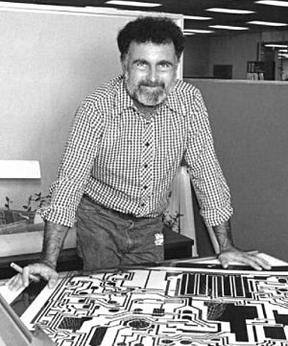
Electronics is a scientific and engineering discipline that studies and applies the principles of physics to design, create, and operate devices that manipulate electrons and other electrically charged particles. Electronics is a subfield of physics and electrical engineering which uses active devices such as transistors, diodes, and integrated circuits to control and amplify the flow of electric current and to convert it from one form to another, such as from alternating current (AC) to direct current (DC) or from analog signals to digital signals.
National Semiconductor Corporation was an American semiconductor manufacturer which specialized in analog devices and subsystems, formerly with headquarters in Santa Clara, California. The company produced power management integrated circuits, display drivers, audio and operational amplifiers, communication interface products and data conversion solutions. National's key markets included wireless handsets, displays and a variety of broad electronics markets, including medical, automotive, industrial and test and measurement applications.
SPICE is a general-purpose, open-source analog electronic circuit simulator. It is a program used in integrated circuit and board-level design to check the integrity of circuit designs and to predict circuit behavior.
In electronics, a linear regulator is a voltage regulator used to maintain a steady voltage. The resistance of the regulator varies in accordance with both the input voltage and the load, resulting in a constant voltage output. The regulating circuit varies its resistance, continuously adjusting a voltage divider network to maintain a constant output voltage and continually dissipating the difference between the input and regulated voltages as waste heat. By contrast, a switching regulator uses an active device that switches on and off to maintain an average value of output. Because the regulated voltage of a linear regulator must always be lower than input voltage, efficiency is limited and the input voltage must be high enough to always allow the active device to reduce the voltage by some amount.

A switched-mode power supply (SMPS), also called switching-mode power supply, switch-mode power supply, switched power supply, or simply switcher, is an electronic power supply that incorporates a switching regulator to convert electrical power efficiently.
A bandgap voltage reference is a voltage reference circuit widely used in integrated circuits. It produces an almost constant voltage corresponding to the particular semiconductor's theoretical band gap, with very little fluctuations from variations of power supply, electrical load, time, temperature.

Analog Devices, Inc. (ADI), also known simply as Analog, is an American multinational semiconductor company specializing in data conversion, signal processing, and power management technology, headquartered in Wilmington, Massachusetts.

An electronic component is any basic discrete electronic device or physical entity part of an electronic system used to affect electrons or their associated fields. Electronic components are mostly industrial products, available in a singular form and are not to be confused with electrical elements, which are conceptual abstractions representing idealized electronic components and elements. A datasheet for an electronic component is a technical document that provides detailed information about the component's specifications, characteristics, and performance. Discrete circuits are made of individual electronic components that only perform one function each as packaged, which are known as discrete components, although strictly the term discrete component refers to such a component with semiconductor material such as individual transistors.

A low-dropout regulator is a type of a DC linear voltage regulator circuit that can operate even when the supply voltage is very close to the output voltage. The advantages of an LDO regulator over other DC-to-DC voltage regulators include: the absence of switching noise ; smaller device size ; and greater design simplicity. The disadvantage is that linear DC regulators must dissipate heat in order to operate.

Robert John Widlar was an American electronics engineer and a designer of linear integrated circuits (ICs).
Linear Technology Corporation was an American semiconductor company that designed, manufactured and marketed high performance analog integrated circuits. Applications for the company's products included telecommunications, cellular telephones, networking products, notebook and desktop computers, video/multimedia, industrial instrumentation, automotive electronics, factory automation, process control, military and space systems. The company was founded in 1981 by Robert H. Swanson, Jr. and Robert C. Dobkin.

The LM317 is an adjustable positive linear voltage regulator. It was designed by Bob Dobkin in 1976 while he worked at National Semiconductor.

Robert Allen Pease was an electronics engineer known for analog integrated circuit (IC) design, and as the author of technical books and articles about electronic design. He designed several very successful "best-seller" ICs, many of them in continuous production for multiple decades.These include LM331 voltage-to-frequency converter, and the LM337 adjustable negative voltage regulator.
Precision Monolithics, Inc. also known as PMI, was an American company based in Santa Clara, California, that developed and produced mixed signal and linear integrated circuits (ICs). It was a pioneer in the fields of digital-to-analog converters and operational amplifiers.
Passivity is a property of engineering systems, most commonly encountered in analog electronics and control systems. Typically, analog designers use passivity to refer to incrementally passive components and systems, which are incapable of power gain. In contrast, control systems engineers will use passivity to refer to thermodynamically passive ones, which consume, but do not produce, energy. As such, without context or a qualifier, the term passive is ambiguous.
James M. Williams was an analog circuit designer and technical author who worked for the Massachusetts Institute of Technology (1968–1979), Philbrick, National Semiconductor (1979–1982) and Linear Technology Corporation (LTC) (1982–2011). He wrote over 350 publications relating to analog circuit design, including five books, 21 application notes for National Semiconductor, 62 application notes for Linear Technology, and over 125 articles for EDN Magazine.

The field-effect transistor (FET) is a type of transistor that uses an electric field to control the flow of current in a semiconductor. It comes in two types: junction FET (JFET) and metal-oxide-semiconductor FET (MOSFET). FETs have three terminals: source, gate, and drain. FETs control the flow of current by the application of a voltage to the gate, which in turn alters the conductivity between the drain and source.
Gabriel Alfonso Rincón-Mora is a Venezuelan-American/Hispanic-American electrical engineer, scientist, professor, inventor, and author who was elected a fellow of the American National Academy of Inventors (NAI) in 2017, Institute of Electrical and Electronics Engineers (IEEE) in 2011, and Institution of Engineering and Technology (IET) in 2009 for contributions to energy-harvesting and power-supply integrated circuits (ICs). Rincón-Mora is the Motorola Solutions Foundation Professor at the Georgia Institute of Technology, where he's been Assistant/Associate/Full Professor since 2001.

Raymond D. "Ray" Zinn is an inventor, entrepreneur and author. In addition to a number of significant inventions improving wireless radio (RF) communication and voltage/power regulation devices, he is also the longest serving chief executive officer of a Silicon Valley company.
Bruno Murari is an Italian inventor. During his career he has patented about 200 inventions in the field of circuit design, power technologies and MEMS devices. He is the only Italian to have received the Elmer A. Sperry Award, which is awarded to those who have distinguished themselves with proven engineering contributions to advance the field of transport. He was defined "legendary analog engineer" and "father" of the BCD technology.









